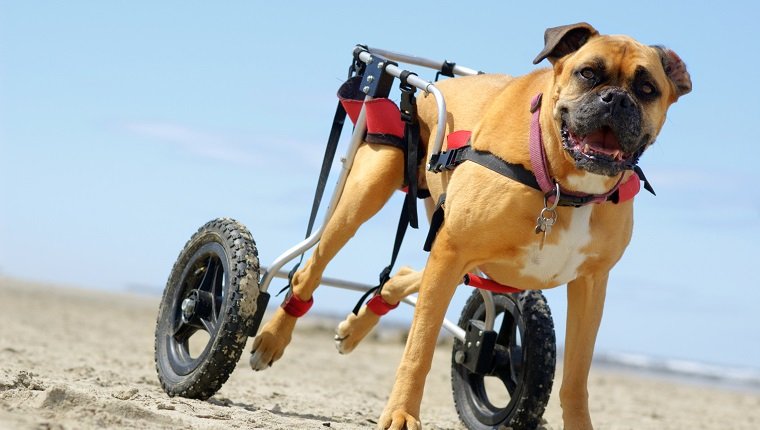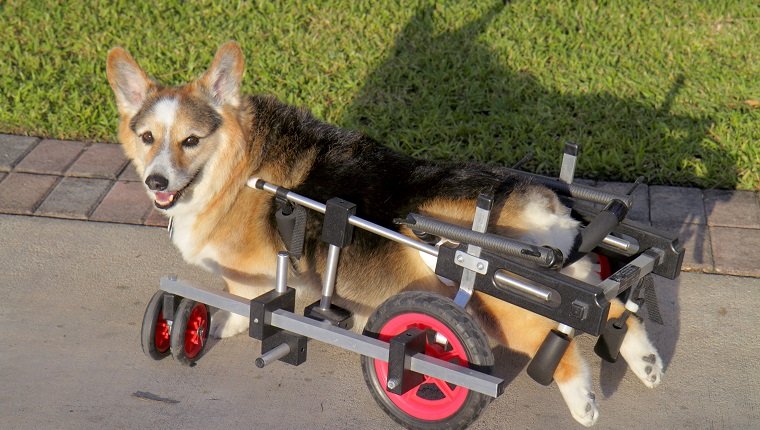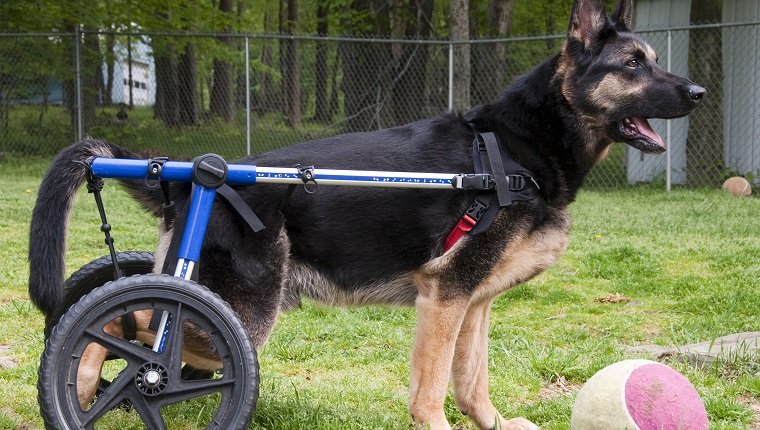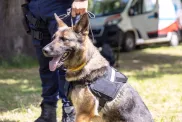Degenerative myelopathy in dogs, also known as chronic degenerative radiculomyelopathy and German Shepherd myelopathy, is a hereditary disease. It causes fibers in the brain, spinal chord, and nerves to break down over time.
This condition usually appears in dogs over the age of seven years old and is more common in certain breeds. It generally results in weakness and a loss of coordination at first. As the condition progresses, it causes total paralysis and then, most often, death.
The condition has no cure, and treatment focuses on providing comfort to dogs for as long as possible. If you see the signs of degenerative myelopathy in your dog, consult your veterinarian so they can inform you of your options and provide any care possible.
Here’s what you should know about the symptoms, causes, and treatments for degenerative myelopathy in dogs.
Symptoms Of Degenerative Myelopathy In Dogs

Symptoms of degenerative myelopathy in dogs usually appear after the age of seven years but may appear as early as age five. They gradually worsen over time, and it may take years before both front and hind legs experience full paralysis.
Fortunately, most dogs do not suffer from any pain associated with the condition, though their quality of life can be drastically affected, and the condition is usually fatal.
However, the time it takes for the disease to progress can vary greatly. Some dogs experience total paralysis within a few months while others survive with the condition for three years or more.
Here are the common symptoms of degenerative myelopathy in dogs:
- Dragging hind paws or rolling the knuckles
- Sores or worn-down nails on hind paws
- Limping or lameness in hind paws that gradually moves to front paws
- Difficulty rising, walking, jumping, or moving
- Loss of balance and coordination
- Muscle wasting
- Increasing paralysis of hind legs (usually total paralysis occurs within six to twelve months of initial symptoms)
- Incontinence
- Bed sores
- Weight gain
- Urine retention
- Urinary tract infection
- Skin lesions from urine scalding
- Increasing paralysis of front legs (usually total paralysis within a few years of initial symptoms)
- Difficulty chewing and swallowing
- Difficulty breathing
Causes Of Degenerative Myelopathy In Dogs

Degenerative myelopathy in dogs is caused by a genetic mutation, specifically in the superoxide dismutase 1 (SOD1) gene, which is the same gene that is associated with Lou Gehrig’s disease in humans.
This mutation almost certainly passes on to puppies as a recessive trait and more commonly appears in certain purebred dogs. Degenerative myelopathy is most often seen in German Shepherds, Boxers, and Pembroke Welsh Corgis.
Several other breeds are capable of inheriting the disease, too, including Cardigan Welsh Corgis, Collies, Retrievers, Rhodesian Ridgebacks, Siberian Huskies, Weimaraners, and Wirehaired Fox Terriers among others.
Treatments For Degenerative Myelopathy In Dogs

Treatment for degenerative myelopathy in dogs is focused on providing support and comfort for affected animals to maintain quality of life, as there is no way to cure the condition or halt its progression.
Some exercises and physical therapy can reduce muscle deterioration and help retain some mobility for as long as possible.
If your vet diagnoses your dog with degenerative myelopathy, they can instruct you on proper stretches and activities that can help your dog maintain muscle strength and the ability to balance and walk for some time. Water exercises and hydrotherapy may also be beneficial.
Dogs may be able to move for a longer amount of time with the aid of a wheelchair, but as the condition progresses, they will become more bedridden. It’s important to provide dogs with soft, clean bedding that must be changed frequently to stop bed sores from developing.
Dogs may need to go on a diet to prevent weight gain.
New therapies and treatments are still being researched, though none have yet been proven to stop the progress of degenerative myelopathy in dogs. Your vet will be able to give you the best recommendations for continued treatment and care for your dog’s individual needs.
Have you ever had a dog who suffered from degenerative myelopathy? How did you keep them comfortable? Let us know in the comments below.









